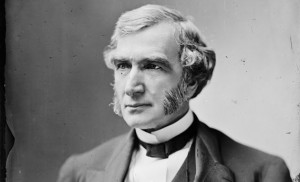Morrill Act changed higher education forever
Justin Smith Morrill was a merchant and a farmer before he spent 44 years serving the citizens of Vermont in Congress. However, perhaps Morrill’s most important attribute was his membership in the Republican Party.
“The Morrill Act was part of a series of Republican laws created during the Civil War,†says Charles Vollan, an SDSU assistant professor of history, who notes that other Republican legislation included the 1862 Banking Act, the Homestead Act and the Pacific Railroad Acts of 1862 and 1864.
The act named for Morrill would change the face of higher education in America, making a university education as egalitarian as it was utilitarian.
The Morrill Act sought to create a system of state universities that would teach agriculture, mechanics and military tactics without excluding literary or scientific studies. The act was a reaction to a long-simmering dissatisfaction with a higher education system designed to teach the offspring of the wealthy about ancient languages and European literature.
“It changed the basic nature of higher education,†Vollan says. “It opened up college to a whole class of ordinary people who hadn’t been able to afford it.â€
Building better-educated workers
The mood was right in the nation for a practical form of education that emphasized agriculture and mechanic arts.
“They were trying to raise up a generation of mechanics,†Vollan says.
There was also a keen interest in new agricultural techniques that would help open up the West to settlement.
“They sought a style of American agriculture that would work in the interior West,†Vollan says.
The Morrill Act fit into the Republican agenda, but Morrill wasn’t merely following the party line. When President Abraham Lincoln signed the Morrill Act into law on July 2, 1862, it was the culmination of a years-long effort by Morrill.
Morrill guided an earlier version of the legislation through Congress in 1859, only to see it vetoed by President James Buchanan. Since the Southern states that opposed the act had left the Union, Morrill’s bill had an easier time getting approval in 1862.
Based on 30,000 acres
 The Morrill Act awarded each state 30,000 acres of public land for each member it had in Congress. The land would be sold to fund the creation of a university.
The Morrill Act awarded each state 30,000 acres of public land for each member it had in Congress. The land would be sold to fund the creation of a university.
According to Vollan, offering land to help fund education was not a new idea. The Northwest Ordinance of 1787 set standards for the way new holdings could make their way from territories to states. The ordinance called for land to be divided into six-mile-by-six-mile townships with section 16 of each grid designated as school land that could be sold to finance the building of a school.
Though the Morrill Act had easy passage in 1862, it was not well received in all quarters. Eastern states were more developed and more populated and, consequently, had more members of Congress so they qualified for more public land. Those developed states didn’t have public land so they were given scrip that allowed them to sell public lands in the nation’s Western states.
Savvy Eastern leaders chose lands that were suited for farming or heavily timbered to ensure a good payday while Western leaders fretted over the loss of their land and a fear that speculation would drive up all land prices.
Vollan notes that some states earned windfalls through their Morrill Act land transactions. “Enough to start MIT, for example.â€
The Morrill Act’s success at turning public land into a means for funding public education was unprecedented. Circumstances were just right for the growing young nation that was still stretching out to the West.
“We had conditions that were favorable to it,†says Vollan, noting that the nation had a wealth of land that was easy to offer because “that land belonged to other people.â€
Old news worth learning
As SDSU prepares to celebrate the 150th anniversary of the Morrill Act, the law’s place in history is secure even if it is not well-known, even on the campuses of land-grant universities.
For his part as an American history educator, Vollan talks about the Morrill Act in all of his classes. He explains to students that they’re attending a land-grant institution created by the Morrill Act and probably better able to afford their education because of the standards that it set.
“It’s a pretty obscure law,†Vollan says, “but so very, very important in every state.â€
Just as politics played a part in the Morrill Act’s passage in Washington, D.C., politics had plenty to do with its enactment in South Dakota.
Better than a prison
In 1881 Brookings lawyer James Scobey headed for the territorial Legislature with two missions: secure the location of the territorial penitentiary for Brookings and a nice political appointment for his law partner.
Gov. Nehemiah Ordway informed Scobey that the political appointment was going to someone else and that the territorial prison would be located in Sioux Falls. Scobey was able to snare a consolation prize for his constituents in Brookings, securing the rights for an agricultural college in the southern half of Dakota Territory.
History shows that states approached their use of the Morrill Act at various speeds. Some waited; some got right to work on a new university. South Dakota was in the second group, working against the traits that defined Western states.
“Western states, ag states, tended to be poorer,†Vollan says, “their citizens hesitant to spend a lot on education.â€
This enthusiasm for higher education showed that South Dakotans were embracing a new philosophy. One that, according to Vollan, said, “Ordinary people not only could, but should, go to college.â€
South Dakotans were so eager for the prospect of new agricultural techniques that would be taught at a land-grant university that the legislation creating what would become South Dakota State University was signed on Feb. 1, 1881, more than eight years before South Dakota entered the Union on Nov. 2, 1889.
Dana Hess







